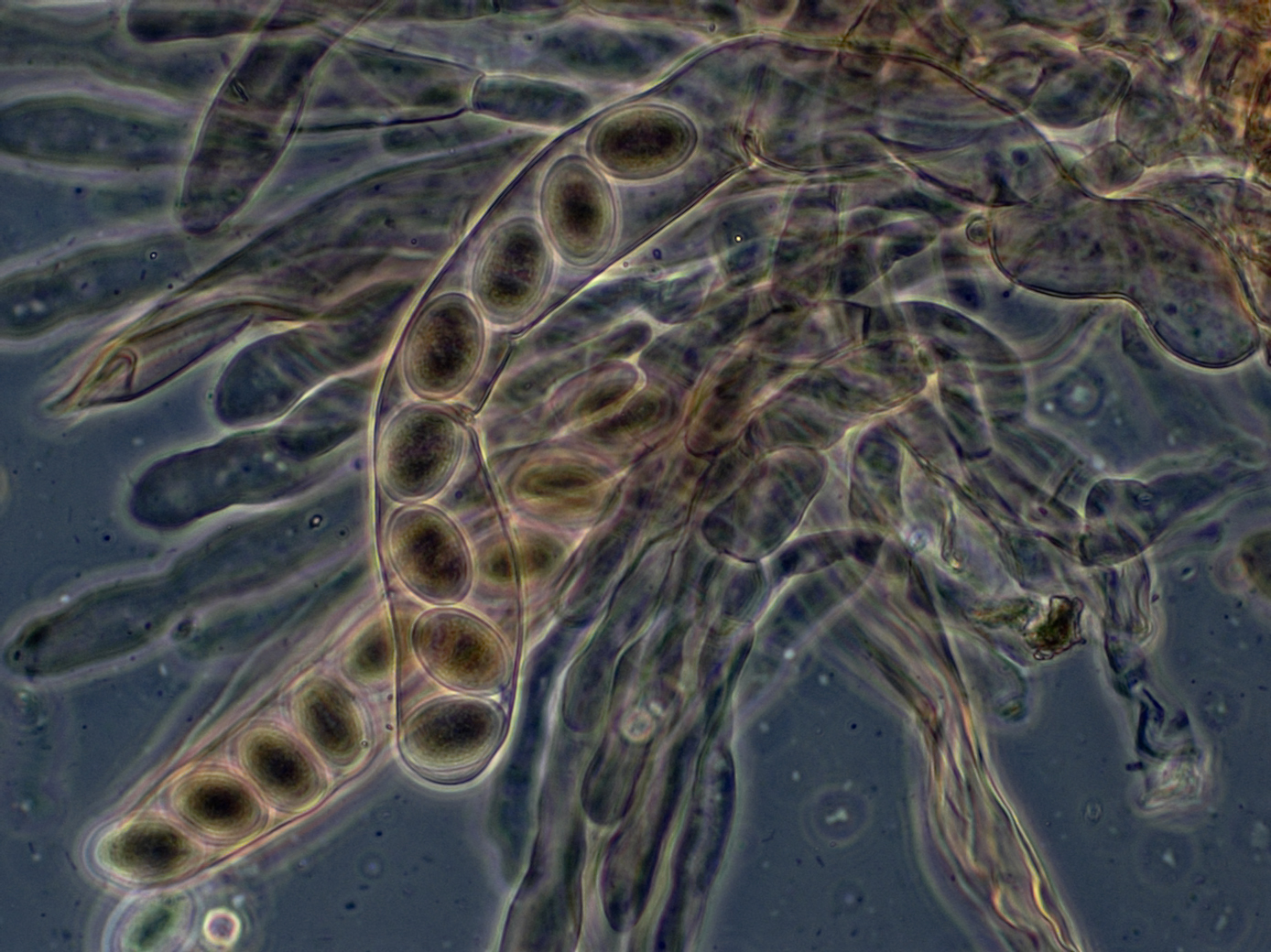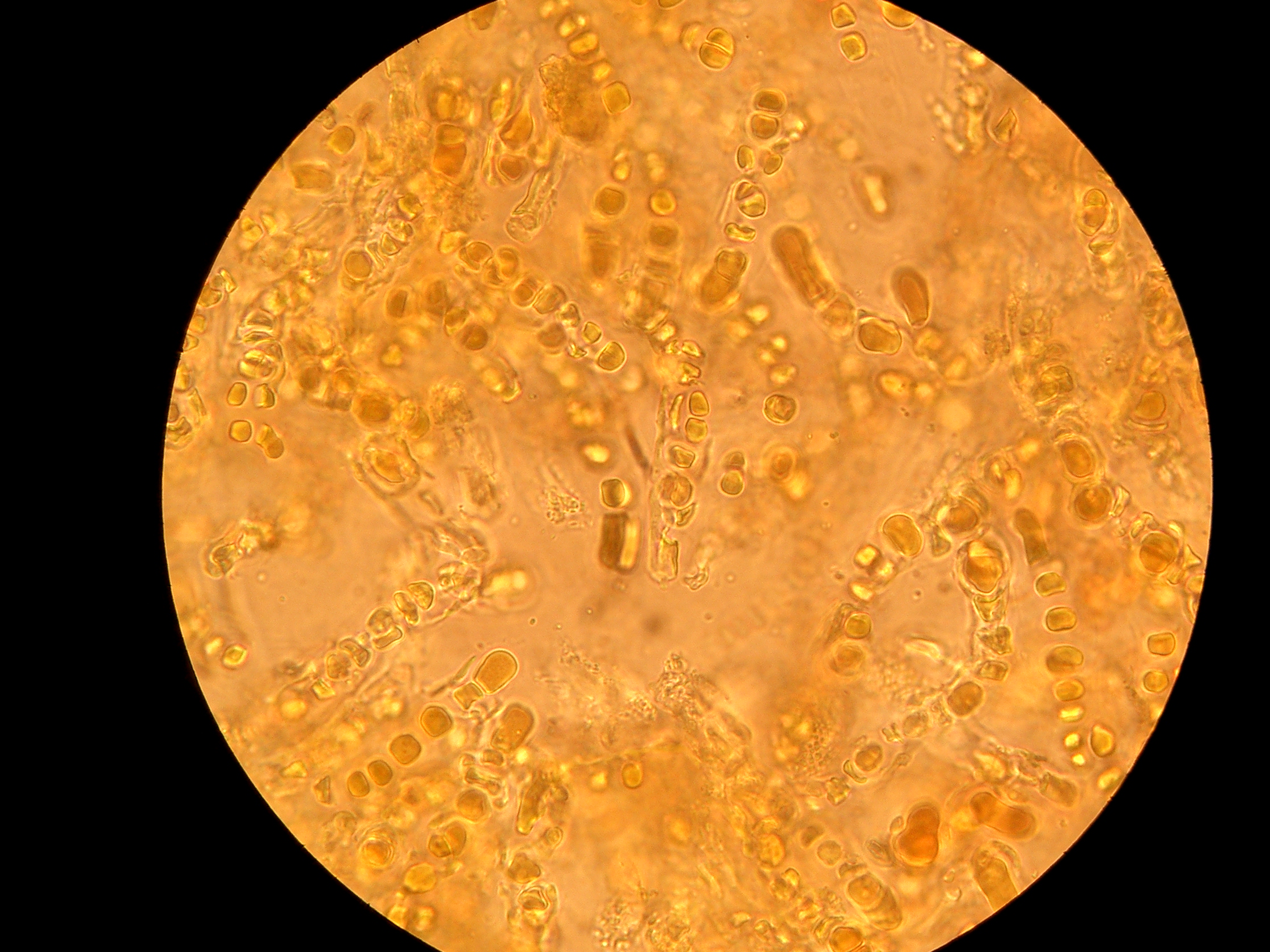|
Leucodecton Canescens
''Leucodecton canescens'' is a species of lichen in the family Graphidaceae. Found in Sri Lanka, it was formally described as a new species in 2014 by lichenologists Gothamie Weerakoon, Robert Lücking and Helge Thorsten Lumbsch. The type specimen was collected from the Maussakanda Tea Estate (Matale, Central Province) at an altitude of . The lichen, which has been recorded from several locations in the Central Province, grows in semi-exposed, disturbed areas at high elevations. The specific epithet ''canescens'' refers to the grey-coloured cover of the thallus. ''Leucodecton canescens'' has a smooth, grey thallus that is 70–100 μm thick with a thin (5–10 μm) cortex. The ascomata are rounded, immersed in the substrate, and measure 0.2–0.3 mm in diameter. The ascospores are muriform, with dimensions of 25–30 by 10–12 μm. Secondary chemicals present in the lichen include stictic acid, constictic acid, acetylconstictic acid, and hypostictic ac ... [...More Info...] [...Related Items...] OR: [Wikipedia] [Google] [Baidu] |
Gothamie Weerakoon
Gothamie Weerakoon ( si, ගෝතමී වීරකෝන්) is a Sri Lankan-based botanist, lichenologist and environmentalist. Early life and education After completing her primary education at the Devi Balika Vidyalaya in Colombo, she attended the University of Colombo, completing her PhD in 2013 at the Sri Jayawardenepura University. She emerged as the most active Sri Lankan lichen researcher. Career She has conducted research on South Asian lichens, discovering over 100 new species endemic to Sri Lanka. Some of the species she has discovered include ''Heterodermia queesnberryi'' and ''Polymeridium fernandoi''. In 2015, she wrote ''Fascinating Lichens of Sri Lanka'', which provides facts about lichen species endemic to Sri Lanka. She currently works as the senior curator of Lichens and Slime Moulds at the Natural History Museum of London and also with tea brand, Dilmah. Awards and recognition She is the first South Asian woman scientist to hold the Annual Grante ... [...More Info...] [...Related Items...] OR: [Wikipedia] [Google] [Baidu] |
Ascospore
An ascus (; ) is the sexual spore-bearing cell produced in ascomycete fungi. Each ascus usually contains eight ascospores (or octad), produced by meiosis followed, in most species, by a mitotic cell division. However, asci in some genera or species can occur in numbers of one (e.g. '' Monosporascus cannonballus''), two, four, or multiples of four. In a few cases, the ascospores can bud off conidia that may fill the asci (e.g. '' Tympanis'') with hundreds of conidia, or the ascospores may fragment, e.g. some '' Cordyceps'', also filling the asci with smaller cells. Ascospores are nonmotile, usually single celled, but not infrequently may be coenocytic (lacking a septum), and in some cases coenocytic in multiple planes. Mitotic divisions within the developing spores populate each resulting cell in septate ascospores with nuclei. The term ocular chamber, or oculus, refers to the epiplasm (the portion of cytoplasm not used in ascospore formation) that is surrounded by the "bo ... [...More Info...] [...Related Items...] OR: [Wikipedia] [Google] [Baidu] |
Taxa Named By Helge Thorsten Lumbsch
In biology, a taxon (back-formation from ''taxonomy''; plural taxa) is a group of one or more populations of an organism or organisms seen by taxonomists to form a unit. Although neither is required, a taxon is usually known by a particular name and given a particular ranking, especially if and when it is accepted or becomes established. It is very common, however, for taxonomists to remain at odds over what belongs to a taxon and the criteria used for inclusion. If a taxon is given a formal scientific name, its use is then governed by one of the nomenclature codes specifying which scientific name is correct for a particular grouping. Initial attempts at classifying and ordering organisms (plants and animals) were set forth in Carl Linnaeus's system in ''Systema Naturae'', 10th edition (1758), as well as an unpublished work by Bernard and Antoine Laurent de Jussieu. The idea of a unit-based system of biological classification was first made widely available in 1805 in the int ... [...More Info...] [...Related Items...] OR: [Wikipedia] [Google] [Baidu] |
Lichens Described In 2014
A lichen ( , ) is a composite organism that arises from algae or cyanobacteria living among filaments of multiple fungi species in a mutualistic relationship.Introduction to Lichens – An Alliance between Kingdoms . University of California Museum of Paleontology. Lichens have properties different from those of their component organisms. They come in many colors, sizes, and forms and are sometimes plant-like, but are not plants. They may have tiny, leafless branches ( fruticose); flat leaf-like structures ( foliose); grow crust ... [...More Info...] [...Related Items...] OR: [Wikipedia] [Google] [Baidu] |
Lichens Of Sri Lanka
A lichen ( , ) is a composite organism that arises from algae or cyanobacteria living among filaments of multiple fungi species in a mutualistic relationship.Introduction to Lichens – An Alliance between Kingdoms . University of California Museum of Paleontology. Lichens have properties different from those of their component organisms. They come in many colors, sizes, and forms and are sometimes plant-like, but are not s. They may have tiny, leafless branches (); flat leaf-like structures ( [...More Info...] [...Related Items...] OR: [Wikipedia] [Google] [Baidu] |
Lichen Species
A lichen ( , ) is a composite organism that arises from algae or cyanobacteria living among filaments of multiple fungi species in a mutualistic relationship.Introduction to Lichens – An Alliance between Kingdoms . University of California Museum of Paleontology. Lichens have properties different from those of their component organisms. They come in many colors, sizes, and forms and are sometimes plant-like, but are not s. They may have tiny, leafless branches ( fruticose); flat leaf-like structures ( [...More Info...] [...Related Items...] OR: [Wikipedia] [Google] [Baidu] |
Morphology (biology)
Morphology is a branch of biology dealing with the study of the form and structure of organisms and their specific structural features. This includes aspects of the outward appearance ( shape, structure, colour, pattern, size), i.e. external morphology (or eidonomy), as well as the form and structure of the internal parts like bones and organs, i.e. internal morphology (or anatomy). This is in contrast to physiology, which deals primarily with function. Morphology is a branch of life science dealing with the study of gross structure of an organism or taxon and its component parts. History The etymology of the word "morphology" is from the Ancient Greek (), meaning "form", and (), meaning "word, study, research". While the concept of form in biology, opposed to function, dates back to Aristotle (see Aristotle's biology), the field of morphology was developed by Johann Wolfgang von Goethe (1790) and independently by the German anatomist and physiologist Karl Fr ... [...More Info...] [...Related Items...] OR: [Wikipedia] [Google] [Baidu] |
Leucodecton Fissurinum
''Leucodecton'' is a genus of lichen-forming fungi in the family Graphidaceae. The genus was circumscribed in 1860 by Swiss lichenologist Abramo Bartolommeo Massalongo, with ''Leucodecton compunctum'' assigned as the type species. Species *'' Leucodecton albidulum'' *''Leucodecton album'' *'' Leucodecton anamalaiense'' *'' Leucodecton biokoense'' *'' Leucodecton bisporum'' *''Leucodecton canescens'' – Sri Lanka *'' Leucodecton compunctellum'' *''Leucodecton compunctum'' *'' Leucodecton confusum'' *'' Leucodecton coppinsii'' *'' Leucodecton dactyliferum'' *''Leucodecton desquamescens'' *'' Leucodecton elachistoteron'' *'' Leucodecton fissurinum'' *'' Leucodecton fuscomarginatum'' – Sri Lanka *''Leucodecton glaucescens'' *''Leucodecton granulosum'' *''Leucodecton inspersum'' *''Leucodecton isidioides'' *''Leucodecton minisporum'' *''Leucodecton nuwarense'' *''Leucodecton occultum'' *''Leucodecton oxysporum'' *''Leucodecton phaeosporum'' *''Leucodecton ps ... [...More Info...] [...Related Items...] OR: [Wikipedia] [Google] [Baidu] |
Constictic Acid
Constictic acid is a chemical compound of the depsidone class. It was first isolated in 1968 from lichen of the genus ''Usnea''. It has since been found in many other lichen genera including ''Menegazzia'', '' Crespoa'', and ''Xanthoparmelia ''Xanthoparmelia'' (commonly known as green rock shields or rock-shield lichens) is a genus of foliose lichen in the family Parmeliaceae.Field Guide to California Lichens, Stephen Sharnoff, Yale University Press, 2014, ''Xanthoparmelia'' is syn ...''. References Lactones Benzaldehydes Heterocyclic compounds with 4 rings Phenols Methoxy compounds Benzodioxepines Lichen products {{organic-compound-stub ... [...More Info...] [...Related Items...] OR: [Wikipedia] [Google] [Baidu] |
Stictic Acid
Stictic acid is an aromatic organic compound, a product of secondary metabolism in some species of lichens. Stictic acid is the subject of preliminary biomedical research. Stictic acid has cytotoxic and apoptotic effects ''in vitro''. Computational studies suggest stictic acid may also stimulate p53 p53, also known as Tumor protein P53, cellular tumor antigen p53 (UniProt name), or transformation-related protein 53 (TRP53) is a regulatory protein that is often mutated in human cancers. The p53 proteins (originally thought to be, and often s ... reactivation. References Phenolic acids Phenol ethers Oxygen heterocycles Lactones Lichen products {{aromatic-compound-stub ... [...More Info...] [...Related Items...] OR: [Wikipedia] [Google] [Baidu] |




